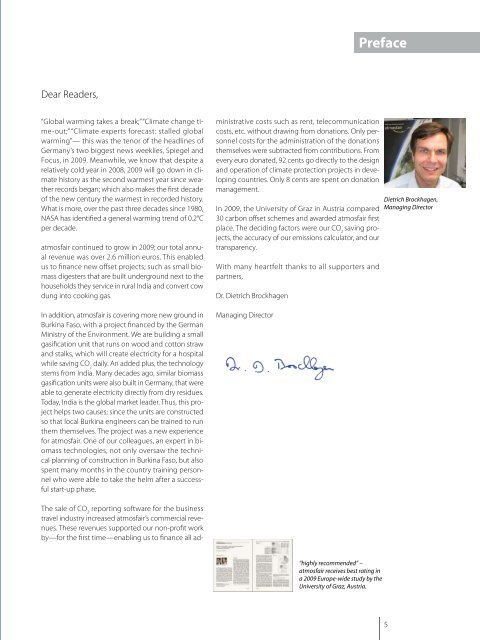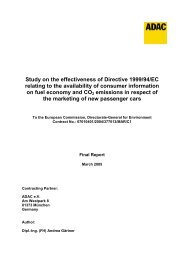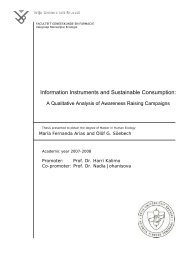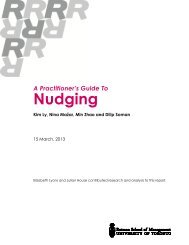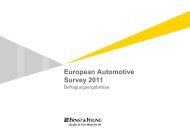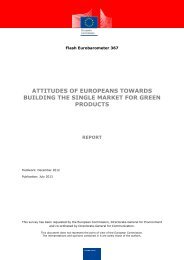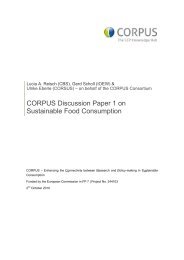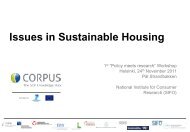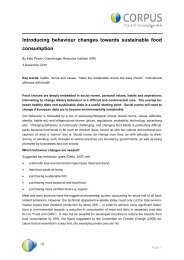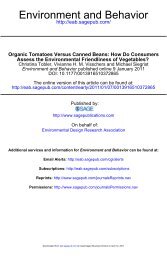Annual Report 2009 - Atmosfair
Annual Report 2009 - Atmosfair
Annual Report 2009 - Atmosfair
You also want an ePaper? Increase the reach of your titles
YUMPU automatically turns print PDFs into web optimized ePapers that Google loves.
Preface<br />
Dear Readers,<br />
“Global warming takes a break;” “Climate change time-out;”<br />
“Climate experts forecast: stalled global<br />
warming”— this was the tenor of the headlines of<br />
Germany’s two biggest news weeklies, Spiegel and<br />
Focus, in <strong>2009</strong>. Meanwhile, we know that despite a<br />
relatively cold year in 2008, <strong>2009</strong> will go down in climate<br />
history as the second warmest year since weather<br />
records began; which also makes the first decade<br />
of the new century the warmest in recorded history.<br />
What is more, over the past three decades since 1980,<br />
NASA has identified a general warming trend of 0.2°C<br />
per decade.<br />
atmosfair continued to grow in <strong>2009</strong>; our total annual<br />
revenue was over 2.6 million euros. This enabled<br />
us to finance new offset projects; such as small biomass<br />
digesters that are built underground next to the<br />
households they service in rural India and convert cow<br />
dung into cooking gas.<br />
In addition, atmosfair is covering more new ground in<br />
Burkina Faso, with a project financed by the German<br />
Ministry of the Environment. We are building a small<br />
gasification unit that runs on wood and cotton straw<br />
and stalks, which will create electricity for a hospital<br />
while saving CO 2<br />
daily. An added plus, the technology<br />
stems from India. Many decades ago, similar biomass<br />
gasification units were also built in Germany, that were<br />
able to generate electricity directly from dry residues.<br />
Today, India is the global market leader. Thus, this project<br />
helps two causes; since the units are constructed<br />
so that local Burkina engineers can be trained to run<br />
them themselves. The project was a new experience<br />
for atmosfair. One of our colleagues, an expert in biomass<br />
technologies, not only oversaw the technical<br />
planning of construction in Burkina Faso, but also<br />
spent many months in the country training personnel<br />
who were able to take the helm after a successful<br />
start-up phase.<br />
The sale of CO 2<br />
reporting software for the business<br />
travel industry increased atmosfair’s commercial revenues.<br />
These revenues supported our non-profit work<br />
by—for the first time—enabling us to finance all administrative<br />
costs such as rent, telecommunication<br />
costs, etc. without drawing from donations. Only personnel<br />
costs for the administration of the donations<br />
themselves were subtracted from contributions. From<br />
every euro donated, 92 cents go directly to the design<br />
and operation of climate protection projects in developing<br />
countries. Only 8 cents are spent on donation<br />
management.<br />
In <strong>2009</strong>, the University of Graz in Austria compared<br />
30 carbon offset schemes and awarded atmosfair first<br />
place. The deciding factors were our CO 2<br />
saving projects,<br />
the accuracy of our emissions calculator, and our<br />
transparency.<br />
With many heartfelt thanks to all supporters and<br />
partners,<br />
Dr. Dietrich Brockhagen<br />
Managing Director<br />
Dietrich Brockhagen,<br />
Managing Director<br />
“highly recommended” –<br />
atmosfair receives best rating in<br />
a <strong>2009</strong> Europe-wide study by the<br />
University of Graz, Austria.<br />
5


